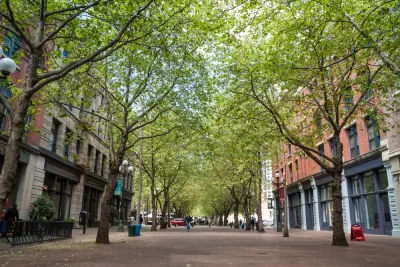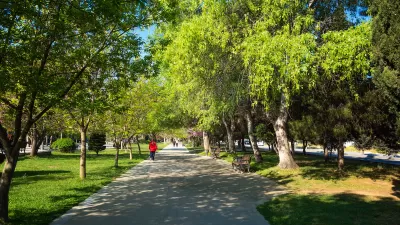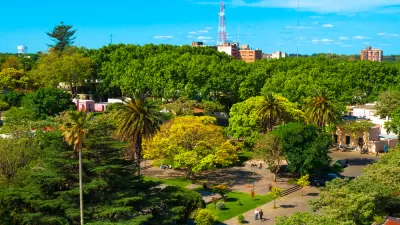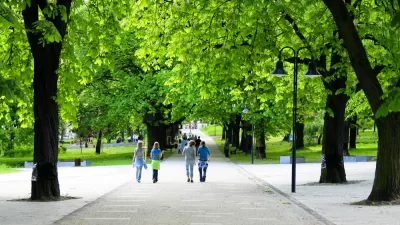As climate change intensifies the urban heat island effect, poorer neighborhoods bear the brunt of tree canopy inequity.

"There are certain visual clues that identify the socioeconomic status of an urban neighborhood," writes Natalie Bicknell, "and in the United States one of these is the presence — or absence — of trees." In order to achieve equity in tree canopy coverage, U.S. cities should plant 522 million trees in urban areas, according to a new tool called the Tree Equity Score (TES). "Combining GIS (Geographic Information System) mapping data with information provided by the United States census on population density, demographics of residents, health trends, and urban heat indexes, the TES uses quantitative analysis to determine whether locations have enough trees to provide optimal health, economic and climate benefits to residents."
An assessment of TES data shows that "[o]n average, American neighborhoods home to a majority of people of color have 33% less tree canopy than majority White neighborhoods," while "neighborhoods with 90% or more of their residents living in poverty have 41% less tree canopy than communities with only 10% or less of the population in poverty." The recent heat wave experienced by the Pacific Northwest brought out the reality of these numbers as close to 100 people in Washington and Oregon died from heat-related causes. "In the Canadian province of British Columbia, the heatwave is thought to have contributed to over 700 sudden deaths in a single week." Meanwhile, the U.S. is losing trees: "approximately one tree is lost for every two trees planted or naturally regenerated in urban areas," which will lead to a decline in tree canopy of 8.3% by 2060.
"The path to planting 522 million trees in urban areas will be a long one, but reframing how trees are viewed in cities might accelerate the process," writes Bicknell. Along with tools like the TES and the National Tree Benefit Calculator (NTBC), "considering trees to be core urban infrastructure and treating them as such could lead to a revaluation of trees in urban settings, provoking cities to invest more in planting and caring for them."
FULL STORY: In Order to Achieve Tree Equity, the U.S. Must Plant 522 Million Trees in Urban Areas

Alabama: Trump Terminates Settlements for Black Communities Harmed By Raw Sewage
Trump deemed the landmark civil rights agreement “illegal DEI and environmental justice policy.”

Study: Maui’s Plan to Convert Vacation Rentals to Long-Term Housing Could Cause Nearly $1 Billion Economic Loss
The plan would reduce visitor accommodation by 25% resulting in 1,900 jobs lost.

Planetizen Federal Action Tracker
A weekly monitor of how Trump’s orders and actions are impacting planners and planning in America.

Waymo Gets Permission to Map SF’s Market Street
If allowed to operate on the traffic-restricted street, Waymo’s autonomous taxis would have a leg up over ride-hailing competitors — and counter the city’s efforts to grow bike and pedestrian on the thoroughfare.

Parklet Symposium Highlights the Success of Shared Spaces
Parklets got a boost during the Covid-19 pandemic, when the concept was translated to outdoor dining programs that offered restaurants a lifeline during the shutdown.

Federal Homelessness Agency Places Entire Staff on Leave
The U.S. Interagency Council on Homelessness is the only federal agency dedicated to preventing and ending homelessness.
Urban Design for Planners 1: Software Tools
This six-course series explores essential urban design concepts using open source software and equips planners with the tools they need to participate fully in the urban design process.
Planning for Universal Design
Learn the tools for implementing Universal Design in planning regulations.
Caltrans
Smith Gee Studio
Institute for Housing and Urban Development Studies (IHS)
City of Grandview
Harvard GSD Executive Education
Toledo-Lucas County Plan Commissions
Salt Lake City
NYU Wagner Graduate School of Public Service





























